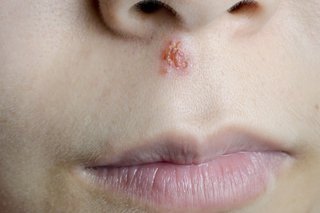Understanding Cold Sore in Nose and Impetigo: A Comprehensive Guide for Parents
Hello, lovely parents! ? Dealing with your little one’s skin issues can be a real worry, right? Well, fear not because we’re here to unpack all you need to know about cold sores in the nose and impetigo. These common yet often misunderstood conditions can cause discomfort for your child, but with the right info, you can tackle them head-on. So sit back, grab a cup of your favorite beverage, and dive into our guide full of helpful tidbits to keep your kiddo smiling and healthy!
What is a Cold Sore in the Nose?
First, let’s chat about cold sores that appear inside the nose – they’re tricky little things. Caused by the herpes simplex virus (HSV), which I know sounds scary, but it’s incredibly common. It can cause blisters or sores not only around the mouth but also inside the nostrils. These can be ticklish, painful, and a bit of a nuisance for your child, but we’ll share tips to soothe the sniffles and keep these sores at bay.
And What About Impetigo?
Moving on to impetigo – sounds like a character from a children’s book, doesn’t it? It’s actually a skin infection caused by bacteria, typically Staphylococcus aureus or Streptococcus pyogenes. It can create red sores or blisters that ooze and form a honey-colored crust (not as sweet as it sounds!) and usually pops up around the nose and mouth. But don’t let impetigo intimidate you, as we’ll go through how to help your child be the superhero in defeating this pesky villain.
Symptoms: Spot the Signs Early
- Cold Sore in Nose Symptoms: A possible tingling sensation before the sore appears, painful blister or clustered blisters, oozing and crusting over.
- Impetigo Symptoms: Itchy red sores that quickly become pus-filled blisters, might rupture and ooze for a few days before forming a yellowish-brown crust; may be accompanied by swollen lymph nodes and fever.
Causes: Knowing Your Nemesis
- Cold Sore Causes: Triggered by HSV-1, these outbreaks can be sparked by stress, illness, fatigue, sunshine, and even the wind – pretty much like a superhero’s list of weaknesses.
- Impetigo Causes: This one is caused by those bacteria we mentioned and can spread through direct contact or sharing items like towels, toys, or clothing with someone who’s infected.
Treatment: Recovery Is on the Horizon
When it comes to treatment, you’ve got options. For cold sores, antiviral creams or oral medications can be knights in shining armor. Comfy and clean tissues will also be your best friends, as keeping the area tidy is crucial.
And impetigo? Your pediatrician might prescribe antibiotic ointments or oral antibiotics to clear it up. Cleanliness is also a superhero here: Regularly washing the affected area with mild soap and water can prevent the spread and help speed up recovery.
Prevention: Your Shield Against Skin Troubles
Prevention is better than cure, they always say, and it’s true! Encouraging handwashing, teaching your kiddos not to share personal items, and keeping a close eye on cuts and scrapes can help prevent impetigo. As for cold sores, avoiding triggers and using lip balm with SPF can be your invisible cloak of protection.
Alrighty, we’ve covered the basics, but don’t you worry, there’s more to come! In the next sections, we’ll dive deeper into home remedies that can soothe symptoms, when to call a doctor, and how to support your child emotionally through these icky skin conditions.
We know dealing with these issues can make you feel like you’re in a battle, but with our guide, you’ll be well-armed to care for your little warrior’s skin. Keep reading for more detailed action plans and tips to ensure your child’s comfort and happiness through it all!

5 Essential Things Parents Should Know About Cold Sores in the Nose and Impetigo
1. Early Detection is Key
Being proactive and vigilant can be your greatest strategy in managing these conditions. For cold sores, noticing the first sign of that tingling sensation can be the best time to start treatment. In the case of impetigo, watching for the first signs of redness or a rash, especially if it’s near a scratch or an insect bite, can help you act swiftly. The sooner these conditions are addressed, the easier they are to manage.
2. Contagion Control
Both conditions are highly contagious. It’s pivotal to instruct your child about the importance of not touching the sores to prevent spreading the infection to other parts of the body or to other people. It may seem a bit of a challenge, especially with younger children, but with gentle reminders and leading by example, it’s entirely doable.
3. The Power of Cleanliness and Personal Hygiene
Clean hands make for a healthy home! Stressing the importance of handwashing can’t be overemphasized. With regular handwashing, you decrease the chance of both cold sores and impetigo spreading. And, if you have an impetigo case on your hands, make sure everyone in the home is using their own towels, bedding, and clothing to keep those germs from throwing a party.
4. Nutritional Support
Supporting your child’s immune system through a well-balanced diet rich in vitamins and minerals can help their body to fend off infections. Foods high in vitamin C and zinc can be true stalwarts aiding in the healing process. And remember, staying well-hydrated is just as important!
5. Emotional Comfort is Crucial
Last but certainly not least, providing emotional support to your child when they’re experiencing these conditions is so important. A cold sore or an impetigo outbreak can affect a child’s self-esteem. Your role as their biggest cheerleader can make all the difference, comforting them and reminding them that these conditions are temporary and common.
When to Seek Medical Advice
While home remedies and over-the-counter treatments can be effective, there are times when you should definitely reach out to your healthcare provider. Instances such as the cold sore not healing within a couple of weeks, symptoms of a secondary infection (like increased redness, warmth, swelling, or pus), and any signs of fever or lethargy mean it’s time to get professional help. Remember, no question or concern is too small especially when it comes to your child’s health.
Home Remedies That Can Bring Comfort
For those times when you’re at home and need a gentle, quick solution, a few home remedies might do the trick. Applying a cool, damp cloth to the sores can decrease redness and soothe pain. A little petroleum jelly can keep the cold sores from drying out and cracking, while honey (for children over one year) has natural antibacterial properties that might help with impetigo.
Wrap-up
There you have it, the inside scoop on dealing with cold sores in the nose and impetigo. With this knowledge in hand, you’re not just a parent; you’re a superhero ready to tackle the villains of the skin infection world. Keep these tips handy, and you’ll always be prepared.
Remember: staying informed, observing good hygiene practices, dealing with infections promptly, comforting and reassuring your child through the process, and knowing when to seek medical help are the keys to effectively managing these conditions.
Together, with this comprehensive guide as your sidekick, you and your little one can face these challenges head-on and come out victorious!
See more great Things to Do with Kids in New Zealand here. For more information see here
Disclaimer
The articles available via our website provide general information only and we strongly urge readers to exercise caution and conduct their own thorough research and fact-checking. The information presented should not be taken as absolute truth, and, to the maximum extent permitted by law, we will not be held liable for any inaccuracies or errors in the content. It is essential for individuals to independently verify and validate the information before making any decisions or taking any actions based on the articles.




